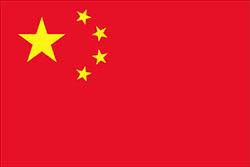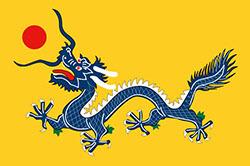 The national flag of the People's Republic of China is one of the greatest symbols of the Chinese nation, next to the coat of arms of the Republic and the Chinese National Anthem.
The national flag of the People's Republic of China is one of the greatest symbols of the Chinese nation, next to the coat of arms of the Republic and the Chinese National Anthem.
The flag of China has a red background with five yellow stars in the left corner, one large and the other four small ones orbiting the right side of the largest star.
In colors and layout, the flag of China resembles the former flag of the Soviet Union, which had a red background and was decorated with a scythe and hammer representing rural and industrial workers, and on top a hollow star in allusion to the Communist Party.
Meaning of China Flag Elements
The red at the bottom of China's flag represents the communist revolution, and the biggest star is the Chinese Communist Party (CCP).
Yellow represents Chinese sunlit soil over red earth, showing the productivity of that territory.
The minor stars do not have an official representation, but they are said to signify the Chinese people and the symbology indicates the population's alignment with the Communist Party, in obedience and reverence.
The most common version for the representation of the four stars is related to the popular classes designated by Mao Tse-tung in his texts. The leader of the Chinese Communist Revolution, and founder of the People's Republic of China, divided the people into four classes: the proletariat, the urban bourgeoisie, the peasant and the rural bourgeoisie. And each one of them would be a little star on the flag.
All five stars have five points. The four smaller ones form an arc alongside the larger one, with one of the vertices facing the main star.
The length to height ratio of the flag of China is 3:2.
History of the Flag of China
The current flag of China was adopted on September 27, 1949, after the Civil War that culminated in the Communist Revolution.
His first public appearance was on October 1, 1949, in Tiananmen Square in Beijing, at the founding of the People's Republic of China.
 But the first Chinese flag was created even in the Empire, during the dynasty immediately preceding the period of the republic, the Qing Dynasty. The imperial flag was used from 1890 to 1912, and it sported a blue dragon against a yellow background and a red sun in the corner.
But the first Chinese flag was created even in the Empire, during the dynasty immediately preceding the period of the republic, the Qing Dynasty. The imperial flag was used from 1890 to 1912, and it sported a blue dragon against a yellow background and a red sun in the corner.
 In 1912, with the Xinhai Revolution that proclaimed the first Republic in China, the emperor's symbol was replaced by a striped version. There were five stripes: red, yellow, blue, white and black. All colors were on the ancient flag of the Empire.
In 1912, with the Xinhai Revolution that proclaimed the first Republic in China, the emperor's symbol was replaced by a striped version. There were five stripes: red, yellow, blue, white and black. All colors were on the ancient flag of the Empire.
 In 1928, the striped flag is replaced by a red-grounded version with a blue rectangle in the left corner and a white 12-ray sun above the rectangle. The former flag of the Republic of China is still used by Taiwan today.
In 1928, the striped flag is replaced by a red-grounded version with a blue rectangle in the left corner and a white 12-ray sun above the rectangle. The former flag of the Republic of China is still used by Taiwan today.
Discover the meaning of the others country flags.
